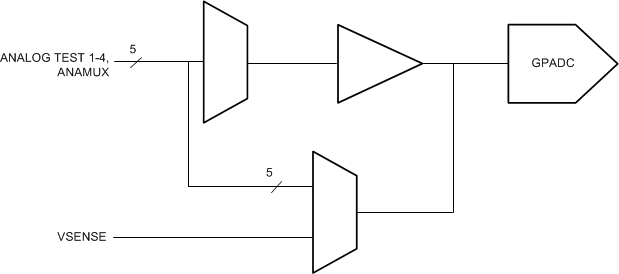ZHCSIZ5E October 2018 – June 2021 IWR6443 , IWR6843
PRODUCTION DATA
- 1 特性
- 2 应用
- 3 说明
- 4 功能方框图
- 5 Revision History
- 6 Device Comparison
- 7 Terminal Configuration and Functions
-
8 Specifications
- 8.1 Absolute Maximum Ratings
- 8.2 ESD Ratings
- 8.3 Power-On Hours (POH)
- 8.4 Recommended Operating Conditions
- 8.5 Power Supply Specifications
- 8.6 Power Consumption Summary
- 8.7 RF Specification
- 8.8 CPU Specifications
- 8.9 Thermal Resistance Characteristics for FCBGA Package [ABL0161]
- 8.10
Timing and Switching Characteristics
- 8.10.1 Power Supply Sequencing and Reset Timing
- 8.10.2 Input Clocks and Oscillators
- 8.10.3
Multibuffered / Standard Serial Peripheral Interface (MibSPI)
- 8.10.3.1 Peripheral Description
- 8.10.3.2
MibSPI Transmit and Receive RAM Organization
- 8.10.3.2.1 SPI Timing Conditions
- 8.10.3.2.2 SPI Master Mode Switching Parameters (CLOCK PHASE = 0, SPICLK = output, SPISIMO = output, and SPISOMI = input) (1) (1) (1)
- 8.10.3.2.3 SPI Master Mode Switching Parameters (CLOCK PHASE = 1, SPICLK = output, SPISIMO = output, and SPISOMI = input) (1) (1) (1)
- 8.10.3.3 SPI Slave Mode I/O Timings
- 8.10.3.4 Typical Interface Protocol Diagram (Slave Mode)
- 8.10.4 LVDS Interface Configuration
- 8.10.5 General-Purpose Input/Output
- 8.10.6 Controller Area Network - Flexible Data-rate (CAN-FD)
- 8.10.7 Serial Communication Interface (SCI)
- 8.10.8 Inter-Integrated Circuit Interface (I2C)
- 8.10.9 Quad Serial Peripheral Interface (QSPI)
- 8.10.10 ETM Trace Interface
- 8.10.11 Data Modification Module (DMM)
- 8.10.12 JTAG Interface
- 9 Detailed Description
- 10Monitoring and Diagnostics
- 11Applications, Implementation, and Layout
- 12Device and Documentation Support
- 13Mechanical, Packaging, and Orderable Information
9.4.1 ADC Channels (Service) for User Application
The IWR6843 device includes provision for an ADC service for user application, where the
GPADC engine present inside the device can be used to measure up to six external voltages. The ADC1, ADC2, ADC3, ADC4, ADC5, and ADC6 pins are used for this purpose.
- ADC itself is controlled by TI firmware running inside the BIST subsystem and access to it for customer’s external voltage monitoring purpose is via ‘monitoring API’ calls routed to the BIST subsystem. This API could be linked with the user application running on MSS R4F.
- BIST subsystem firmware will internally schedule these measurements along with other RF and Analog monitoring operations. The API allows configuring the settling time (number of ADC samples to skip) and number of consecutive samples to take. At the end of a frame, the minimum, maximum and average of the readings will be reported for each of the monitored voltages.
GPADC Specifications:
- 625 Ksps SAR ADC
- 0 to 1.8V input range
- 10-bit resolution
- For 5 out of the 6 inputs, an optional internal buffer (0.4-1.4V input range) is available. Without the buffer, the ADC has a switched capacitor input load modeled with 5pF of sampling capacitance and 12pF parasitic capacitance (GPADC channel 6, the internal buffer is not available).

GPADC structures are
used for measuring the output of internal
temperature sensors. The accuracy of these
measurements is ±7°C.
Figure 9-6 ADC
Path